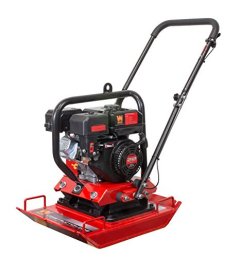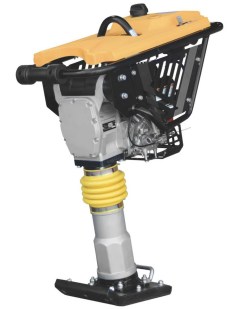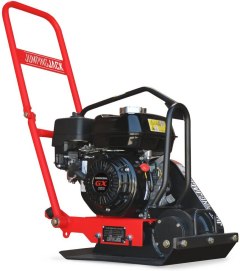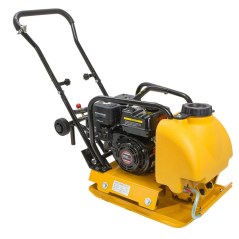BestReviews is reader-supported and may earn an affiliate commission. Details

A powerful engine makes this pick perfect for small or large-scale use.
Has a compact design that allows it to be used in tight spaces where other compacters may not reach. The engine provides enough power for 3000 pounds of force. Backed with a 3-year motor warranty.
The idle control can be a little tricky to use when the machine is on.

We love this powerful yet maneuverable compactor that is well-suited for patio, walkway, and landscaping jobs.
Forward movement rate is excellent, helping jobs go faster. Powerful engine produces 5,400 blows per minute while vibration-reduction features aid operator. Easy to maneuver thanks in part to a unique swing-over handle and compact, contoured edge plate.
Heavier than most models but has central loading bar.

The compact design of this rammer makes it ideal for all manners of work
With a 13-inch by 11-inch steel shoe and 3,000 pounds of force, this rammer is designed for the compaction of cohesive and granular soils that are up to 26 inches. Has a great warranty.
Pretty expensive when compared to other products on the market.

Remains compact and easy to transport without lacking power.
Has a built-in lifting hook that makes it easy to lift in and out of truck beds. Can compact soils and sand as well as loose brick. Powered by a Honda engine that provides 5.5 horsepower.
The handle can be hard to hold for long periods of time.

Has a ton of features that allow it to shine on a daily basis.
The built-in water tank helps the soil have the perfect moisture level for solid compaction. Provides 4000 pounds of impact. The wheel kit can be taken off and on. Easy to reach throttle control.
Can be a bit wide for some smaller spaces.

We recommend these products based on an intensive research process that's designed to cut through the noise and find the top products in this space. Guided by experts, we spend hours looking into the factors that matter, to bring you these selections.

Thorough compaction is essential to provide a stable base for paving, driveways, patios, and walls. There is simply no substitute for a plate compactor if you want to guarantee that your work will last without cracking or lifting. That’s why you find these machines among the equipment of just about every professional construction crew.
But they aren’t just for major projects. DIY enthusiasts can take advantage of relatively lightweight models for paving projects or laying patios and driveways. What’s more, depending on the task, it might be just as cost-effective to buy one as to rent, and they tend to hold their value well if you want to sell it later.
We’ve been looking at the current models and the features they offer so we can help you decide which one would be best for your tasks.

Plate compactors (also known as vibrating plates or wacker plates) can be electric, gas, diesel, or compressed air.
Electric: You might expect electric models to be aimed at homeowners, but that’s not actually the case. Cordless models are quite unlike normal power tools, with 24-volt models that run off a pair of car batteries! As you might guess, these are heavyweight devices. Corded models are equally robust. They’re mainly used in areas where sound is an issue.
Compressed air: These plate compressors are another somewhat specialized choice. The need for an air hose makes them cumbersome, but they can be used inside buildings (where a gas or diesel machine could not), in trenches where fumes might accumulate, or where sparks would be dangerous.
Diesel: Large, heavy-duty machines have diesel engines because the fuel is more economical than gas and the motors tend to be more durable. However, the initial expense means they’re only really found on commercial equipment.
Gas: This leaves gas power as the most convenient and cost-effective for light- and medium-duty plate compactors. While these are what we focus on here because they have the widest range of applications, many of the principles apply to models of all sizes.
Cubic centimeters and horsepower have an impact on performance, of course, but there are other features of these tools that are equally important, if not more so. So while we don’t want to spend too much time on this aspect, it’s worth considering reliability. All kinds of motors are available, some from manufacturers you may not have heard of. While they might be dependable, makers like Briggs & Stratton, Honda, and Kohler have a reputation for quality and durability that almost invariably makes them worth the investment.
The plates themselves are often pressed steel (usually with curved or beveled edges to keep them from digging in). High-quality machines use cast iron. The extra weight can improve performance where high compaction is desired, and it’s less likely to distort over time.
Size: Plate compactors are often rated by plate size, though it’s a better indicator of maneuverability and the space it can work in than overall performance. For example, among the machines we looked at is one with a plate of 12 x 17 inches and another of 14 x 21 inches. Yet the former has a 260-cubic centimeter, 6-horsepower motor, and the latter has a 96-cubic centimeter, 2.5-horsepower motor, so in this case the physically smaller machine is considerably more powerful.
The variety of tasks these tools are used for means there isn’t really an ideal all-rounder, so one of the key aspects of choosing your plate compactor is the type of work you need to do most of the time. A powerful machine with a small plate delivers greater intensity, so it will provide high compaction quickly — just what you want for deep bases. However, if you’re working with asphalt, you generally want to spread the load. In that case, a large plate would provide optimum performance.
Pounds per square inch: A common headline figure is compaction force, measured in pounds per square foot (psi). Light-duty machines start at around 1,500, medium-duty machines at roughly 3,000, and heavy-duty compactors at 6,000 and up.
Beats per minute: The other important number is beats or vibrations per minute, which are effectively the same thing. Numbers are usually in excess of 4,000, with some over 6,000. Perhaps not surprisingly it’s frequently lighter machines that work fastest, and this can be very effective when working with fine gravel, for instance.
Compaction depth: This may also be given, and it is anywhere from 8 to 24 inches on the plate compactors we looked at. However, the figure is somewhat subjective and depends very much on the materials being compacted. Perhaps it’s useful as a way to differentiate between two very similar models.
Travel speed: As all plate compactors are self-propelled (unless you’re going uphill), you’ll also often find a travel speed in feet per minute. Though you might expect light machines to be fastest, it’s not necessarily the case. Somewhere between 50 and 70 feet per minute is typical. It’s a figure that’s more important if you’re laying large areas of asphalt than the base for a patio. Throttle control is often quite rudimentary, using the old-style thumb levers you used to find on lawn mowers.
A properly compacted base means your driveway and paved areas can stand the weight of vehicles or changing atmospheric conditions without distorting.
Reversible: The term “reversible” is used to describe a handle that can flip from one side to the other, so you can drive in two directions. You can push from either side rather than having to pull back.
Anti-vibration: Using a plate compactor all day is tiring, and the vibrations that make it so effective can also make it very uncomfortable. Frequent breaks are recommended, but you’ll also find some models have anti-vibration handles to help damp out much of the effect.
Depending on where you live, it may be necessary for the motor to be CARB compliant. Many are not. EPA compliance is another indicator of reduced emissions, which also usually means the motor is more efficient and so uses less fuel.
The addition of water is sometimes suggested to help the base materials bond together. A plate compactor with a built-in water tank is more convenient and more precise than using a hose.
Warranty length sometimes depends on whether you’re a homeowner or a commercial user. For instance, some models cover a couple of years if you’re a homeowner but only 90 days if you’re a professional. It’s not always the case, but it’s worth checking.

Inexpensive: The cheapest plate compactors we found cost between $450 and $550. There are some good tools in this range for homeowners with modest requirements.
Mid-range: Midsize professional gear starts at about $700 and goes up to around $1,500. These are powerful, reverse-direction machines that are still compact enough to be highly maneuverable.
Expensive: Heavy-duty construction equipment can easily be $2,000, with diesel power at $4,000 or more and top models at over $6,000.
If you’re looking for a model with a water tank, see if it comes off easily. It takes much less effort to remove the tank for refilling rather than moving the entire machine.
In spite of their immense power, plate compactors are pretty safe devices as long as you’re reasonably careful and take a few precautions.

A. Light- and medium-duty homeowner models are very manageable for those of average fitness, and it shouldn’t jump around all over the place. If it does, there may be a fault in the machine, an obstruction (like a rock just below the surface), or the area you’re working on may have reached maximum compaction. Of course, using one for extended periods is bound to be tiring, so be careful you don’t overdo it.
A. It depends on the type, though they all have things like drive belts and bearings that need attention from time to time. Electric and air models have minimal requirements (though the latter have a compressor with its own service routine). Gas and diesel models have similar demands to lawn mowers. Air filters can be prone to clogging in dusty environments. It’s not major work, but it’s essential to maximize the tool’s working life.
A. Absolutely. Any kind of construction benefits from a solid subbase. In general, you want to work on dirt that’s thoroughly dry. If it’s damp, and you’ve got to get the job done, experts recommend mixing in a little fine gravel to help it bind.
Get emails you’ll love.
Learn about the products you’re wondering if you should buy and get advice on using your latest purchases.
BestReviews wants to be better. Please take our 3-minute survey,
and give us feedback about your visit today.
